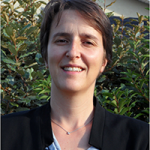(Prof. Dany Carlier, University of Bordeaux, France)
Ab initio calculations based on the Density Functional Theory (DFT) can be used to better understand electrode materials for Li or Na-ion batteries and the intercalation/deintercalation processes, and to find out new interesting materials. In this presentation, we will focus on positive electrode materials as TM layered oxides and polyanionic compounds.
Using several examples, we will show how DFT calculations can provide information on different aspects:
• Structure of the initial phases: stable phases, presence of defects and impact on the electrochemical properties, stable sites or ordering …
• Electronic structure of the materials: electronic configuration of transition metal ions (eg Jahn-Teller distortion, oxidation states etc …), nature of the chemical bonds, redox processes, link with the electrochemical voltages.
• Understanding the phase transitions occurring during the intercalation / deintercalation of the alkali ions.
• Understanding the diffusion paths of ions in the structures and computation of the related energies.
Biography of Prof. Dany Carlier
Dany Carlier is a professor at the University of Bordeaux. She is doing her research activity in a CNRS laboratory : ICMCB (Condensed Matter Chemistry Laboratory). After obtaining her PhD at the University of Bordeaux in 2001, she joined the research group of Pr. Ceder at MIT (Massachusetts Institute of Technology) in 2002 then the group of Pr. Ansermet at EPFL (Ecole Polytechnique Fédérale de Lausanne-Switzerland) in 2003. In 2004, she got a permanent position at the University of Bordeaux.
Her research activities concerns layered transition metal oxides and transition metal phosphates materials as positive electrode for Li-ion and Na-ion batteries. She is especially interested in understanding the mechanisms associated with the alkaline ions intercalation/deintercalation and the structure-properties relationships. In this purpose, she is more specifically developing joint NMR and DFT calculations studies.
She is a member of the advisory board of the European network “p-NMR : Pushing the Envelope of Nuclear Magnetic Resonance Spectroscopy for Paramagnetic Systems. A Combined Experimental and Theoretical Approach”. She received the Excellence Scientific award in 2011, a starting grant form Dupont Company in 2005 and a Lavoisier Fellowship from the French ministry of foreign affairs in 2002.
